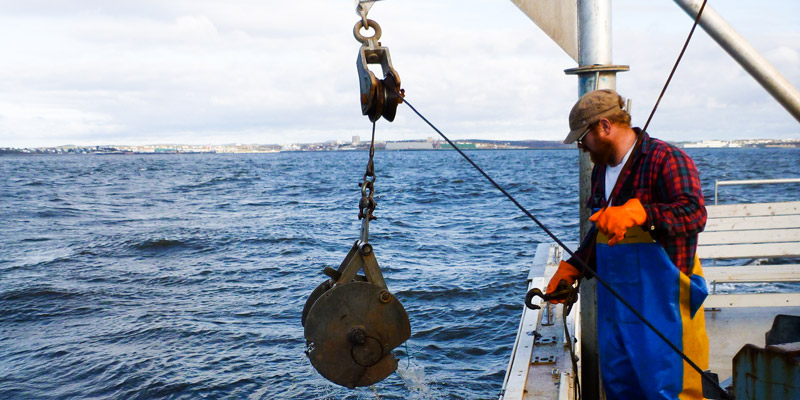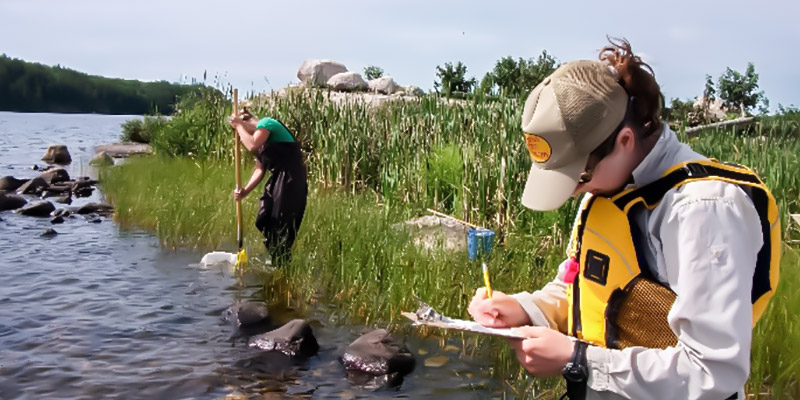The Development of a Framework for Assimilative Capacity of the Saint John River (Phase 2)
Principal Investigator - Kelly Munkittrick, University of New Brunswick, 2001 - 2004

Challenge
Environmental clean-ups can have enormous costs, and development assessments tend to use precautionary approaches due to an inadequate understanding of potential development impacts. Existing water allocation plans, river classification programs, land use planning documents and watershed management plans do not openly consider assimilative capacity because of the absence of a quantifiable procedure or assessment process. Because of this, most development is regulated under fish habitat protection requirements and chemical risk assessment procedures. An effects-based approach to understanding assimilative capacity would provide a mechanism to evaluate the capacity of the system to assimilate wastes, and provide a focal point for regulation, monitoring and mitigation to improve cost-effectiveness and reduce unnecessary expenditures.
This research combines a social and ecological approach to decision making. It focuses on developing a retrospective assessment process and a predictive model for assimilative capacity in the Saint John River in New Brunswick. This research offers new information to apply watershed-level environmental risk assessments and assists watershed managers and government regulators in setting priorities for remediation and treatment, while encouraging an ecosystem focus with local watershed groups.
Project
Phase 1 of this project focused on the freshwater portions of the river and Phase 2 expanded studies into estuarine portions downriver. Initial studies focused on the impacts of nutrient addition as one of the leading causes of environmental degradation of estuarine and coastal waters. The team completed studies on coastal fish processing plants, and on sewage discharges in the estuarine region of the Saint John. In order to identify potential sentinel species for monitoring, they also conducted a seasonal survey of species abundances and movements in the estuarine and near shore areas of the Saint John River, including fish caging, a successful approach for monitoring the impact of point source pollution.
The project used historical and recent water quality data collected by the provincial government, with a supplemental water sampling program to determine nutrient limitation, diel dissolved oxygen and decomposition rates in the freshwater portions of the river. These studies allowed the researchers to integrate nutrient and contaminant issues with decision-making processes among the partners and influence decisions on nutrient management in the upper basin.
Researchers developed the concept of ecosystem services as it related to assimilative capacity, producing a framework and discussion paper for public discussion. The research team worked directly with local watershed groups to encourage an ecosystem focus in their operating practices using a transformative learning approach. They found that there are over 160 community-based organizations devoted to natural resource or watershed conservation or management in the province, most groups being small, not-for profit, and lacking secure funding, while expressing a need for capacity-building and technical training. This research component involved a plan and preliminary assessment of the data requirements to incorporate social and economic considerations into the modeling of assimilative capacity.
Outputs
- Researchers presented their framework and discussion paper on a watershed approach to assimilative capacity as a case study at a joint workshop hosted by the United Nations University’s International Network on Water, Environment and Health (UNU-INWEH) and UNESCO-MAB-IHP entitled “International Workshop on Water and Ecosystems: Water Resources Management in Diverse Ecosystems and Providing for Human Needs.” in Hamilton, Ontario in June 2005. They also interacted with watershed groups from across New Brunswick, facilitating a face to face meeting in November 2005.
- In the summer of 2005, the research team signed a joint agreement with the UNU-INWEH to become the North American Virtual Learning Centre for training in watershed management.
- Research team hosted an international workshop on “Linking Watersheds” in February 2006, which included representatives of watersheds in 17 countries. The workshop included a summary of the tools used for watershed planning and the lessons learned from successful international studies.
- The project produced an hour-long documentary film, available on DVD and on the internet, regarding the historic and current socioeconomic and biophysical conditions of the Canaan-Washademoak Watershed, discussing fish populations, habitat assessments, and water chemistry along with the story of the watershed as told by many of its long-time residents.
Select Presentations
- Jardine, T. and K. Kidd. Mercury sources and fate in the Grand Lake region of the St. John River. State of the St. John River Workshop, Fredericton, NB, 8-9 Jan 2007.
- Theriault, M.-H., S.C. Courtenay, K.R. Munkittrick and A.G. Chiasson. 2007. The effect of seafood processing plant effluent on sentinel fish species in coastal waters of the Southern Gulf of St. Lawrence, New Brunswick. Water Qual. Res. J. Can. 42:172-183.
- Vallières, G., Munkittrick, K.R. and MacLatchy, D.L. 2007. Assessing fish community structure in relation to water quality in a small estuarine stream receiving oil refinery effluent. Water Qual. Res. J. Can. 42: 72-81.
- Freedman, J.A., R.A. Curry and K.R. Munkittrick. 2012. Stable isotope analysis reveals anthropogenic effects on fish assemblages in a temperate reservoir. Rivers Res Appl. 28:1804-1819
- Barrett, T.J. and K.R. Munkittrick. 2010. Seasonal reproductive patterns and recommended sampling times for sentinel fish species used in environmental effects monitoring programs in Canada. Environ. Rev. 18:115-135.
- McMullin, V.A., K.R. Munkittrick, and D.A. Methven. 2010. Spatial variability of reproductive and size characteristics of the northern mummichog (Fundulus heteroclitus macrolepidotus) collected near municipal wastewater discharges. Water Quality Res J Can 45:25-34.
- Kidd, S.D., R.A. Curry and K.R. Munkittrick (Eds.). 2011. The Saint John River: A state of the environment report. University of New Brunswick, Fredericton, NB, Canada. 175 p. ISBN 978-1-55131-158-6
Outcomes
- Increased knowledge in relation to the watershed approach to assimilative capacity.
- Increased capacity with the creation of the North American Virtual Learning Center for training in watershed management.
- Development of international collaborations and relationships with UNU-INWEH, as well as with representatives from 17 countries.




